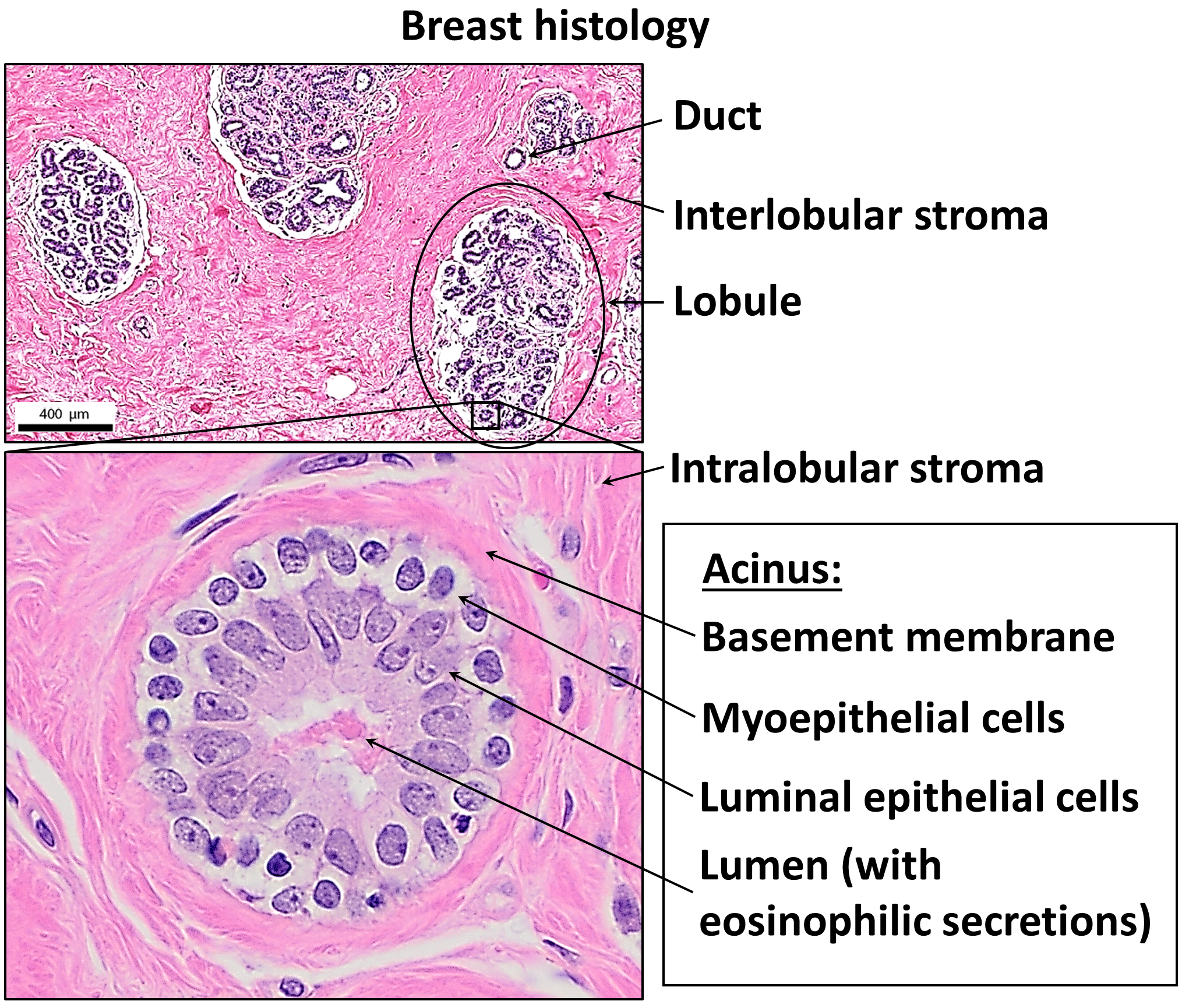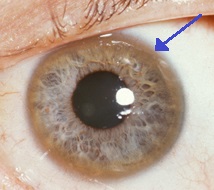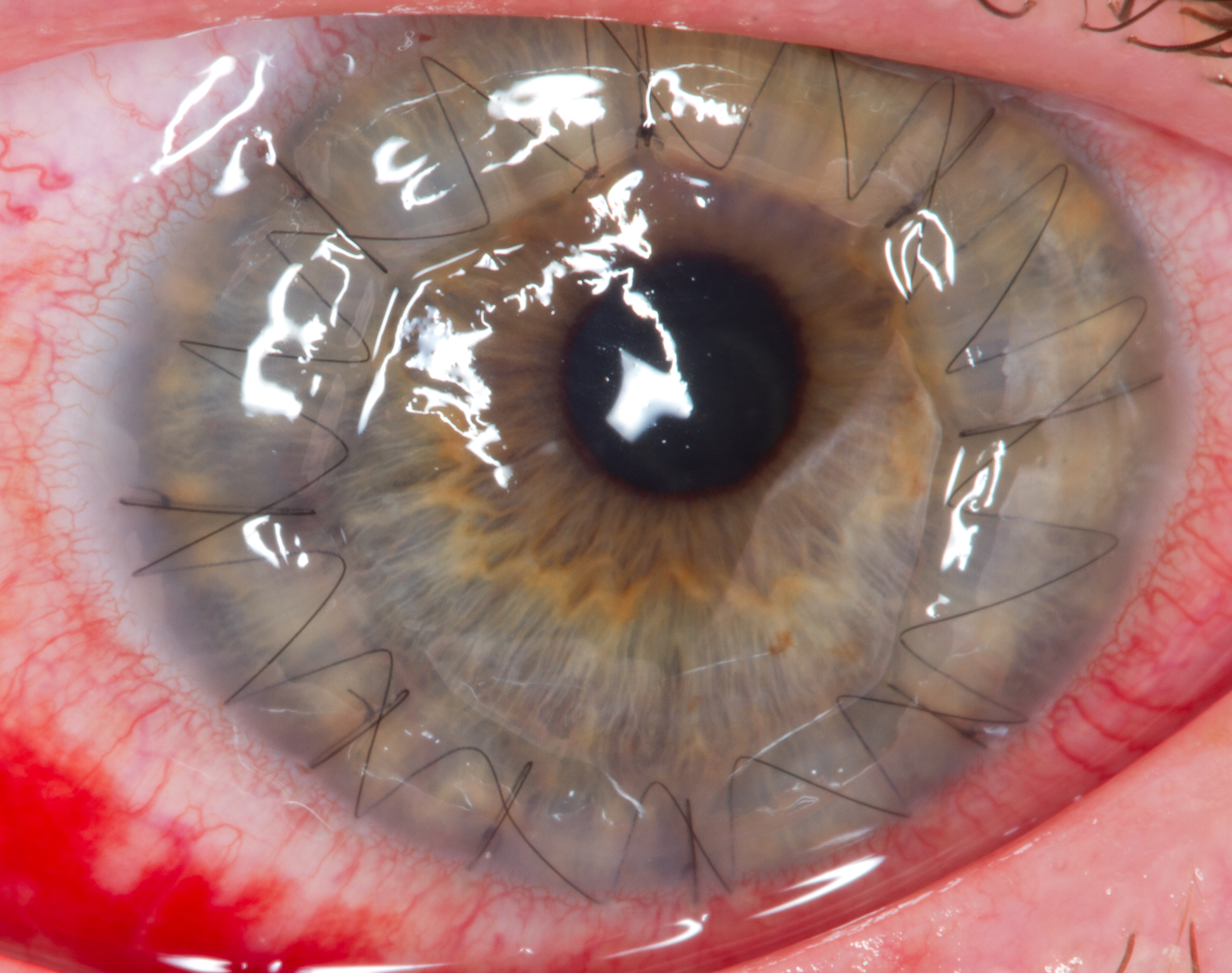|
Descemet's Membrane
Descemet's membrane ( or the Descemet membrane) is the basement membrane that lies between the corneal proper substance, also called stroma, and the endothelial layer of the cornea. It is composed of different kinds of collagen (Type IV and VIII) than the stroma. The endothelial layer is located at the posterior of the cornea. Descemet's membrane, as the basement membrane for the endothelial layer, is secreted by the single layer of squamous epithelial cells that compose the endothelial layer of the cornea. Structure Its thickness ranges from 3 μm at birth to 8–10 μm in adults.Johnson DH, Bourne WM, Campbell RJ: The ultrastructure of Descemet's membrane. I. Changes with age in normal cornea. Arch Ophthalmol 100:1942, 1982 The corneal endothelium is a single layer of squamous cells covering the surface of the cornea that faces the anterior chamber. Clinical significance Significant damage to the membrane may require a corneal transplant. Damage caused by the hereditary c ... [...More Info...] [...Related Items...] OR: [Wikipedia] [Google] [Baidu] |
Epithelium
Epithelium or epithelial tissue is a thin, continuous, protective layer of cells with little extracellular matrix. An example is the epidermis, the outermost layer of the skin. Epithelial ( mesothelial) tissues line the outer surfaces of many internal organs, the corresponding inner surfaces of body cavities, and the inner surfaces of blood vessels. Epithelial tissue is one of the four basic types of animal tissue, along with connective tissue, muscle tissue and nervous tissue. These tissues also lack blood or lymph supply. The tissue is supplied by nerves. There are three principal shapes of epithelial cell: squamous (scaly), columnar, and cuboidal. These can be arranged in a singular layer of cells as simple epithelium, either simple squamous, simple columnar, or simple cuboidal, or in layers of two or more cells deep as stratified (layered), or ''compound'', either squamous, columnar or cuboidal. In some tissues, a layer of columnar cells may appear to be stratified d ... [...More Info...] [...Related Items...] OR: [Wikipedia] [Google] [Baidu] |
Basement Membrane
The basement membrane, also known as base membrane, is a thin, pliable sheet-like type of extracellular matrix that provides cell and tissue support and acts as a platform for complex signalling. The basement membrane sits between epithelial tissues including mesothelium and endothelium, and the underlying connective tissue. Structure As seen with the electron microscope, the basement membrane is composed of two layers, the basal lamina and the reticular lamina. The underlying connective tissue attaches to the basal lamina with collagen VII anchoring fibrils and fibrillin microfibrils. The basal lamina layer can further be subdivided into two layers based on their visual appearance in electron microscopy. The lighter-colored layer closer to the epithelium is called the lamina lucida, while the denser-colored layer closer to the connective tissue is called the lamina densa. The electron-dense lamina densa layer is about 30–70 nanometers thick and consists of an und ... [...More Info...] [...Related Items...] OR: [Wikipedia] [Google] [Baidu] |
Haab's Striae
Haab's striae, or Descemet's tears, are horizontal breaks in the Descemet membrane associated with congenital glaucoma Primary congenital glaucoma is a rare eye condition that is present at birth or develops early in childhood. It occurs due to improper drainage of the eye's fluids, which leads to increased pressure inside the eye, known as intraocular pressure. Th .... It is named after Otto Haab. These occur because descemet's membrane is less elastic than the corneal stroma. Tears are usually peripheral, concentric with limbus and appear as line with double contour. References External links * Ophthalmology Disorders of sclera and cornea {{Med-sign-stub ... [...More Info...] [...Related Items...] OR: [Wikipedia] [Google] [Baidu] |
Jean Descemet
Jean Descemet was a French physician and botanist (1732–1810) who first described what is now known as Descemet's membrane of the eye. He studied medicine in Paris (doctorate in 1757) and in 1759 he published a ''Catalog of the plants in the Garden of the Apothecaries in Paris according to their genera and the characteristics of their flowers, using Mr. Tournefort's method'' (French: ''Catalogue des plantes du jardin de MM. les apothicaires de Paris, suivant leurs genres et les caractères des fleurs, conformément à la méthode de M. Tournefort'') (1759). He is also known for his book ''Observations sur la choroide'', which describes the choroid The choroid, also known as the choroidea or choroid coat, is a part of the uvea, the vascular layer of the eye. It contains connective tissues, and lies between the retina and the sclera. The human choroid is thickest at the far extreme rear o ... layer of the eye and was published in 1768 by L'Imprimerie Royale. References ... [...More Info...] [...Related Items...] OR: [Wikipedia] [Google] [Baidu] |
Kayser–Fleischer Ring
Kayser–Fleischer rings (KF rings) are dark rings that appear to encircle the cornea of the human eye, eye. They are due to copper deposition in the Descemet's membrane as a result of particular liver diseases. They are named after Germany, German ophthalmologists Bernhard Kayser and Bruno Fleischer who first described them in 1902 and 1903. Initially thought to be due to the accumulation of silver, they were first demonstrated to contain copper in 1934. Presentation The rings, which consist of copper deposits where the cornea meets the sclera, in Descemet's membrane, first appear as a crescent at the top of the cornea. Eventually, a second crescent forms below, at the "six o'clock position", and ultimately completely encircles the cornea. Associations Kayser–Fleischer rings are a sign of Wilson's disease, which involves abnormal copper handling by the liver resulting in copper accumulation in the body and is characterised by abnormalities of the basal ganglia of the brain, ... [...More Info...] [...Related Items...] OR: [Wikipedia] [Google] [Baidu] |
Wilson's Disease
Wilson's disease (also called hepatolenticular degeneration) is a genetic disorder characterized by the excess build-up of copper in the body. Symptoms are typically related to the brain and liver. Liver-related symptoms include vomiting, weakness, fluid build-up in the abdomen, swelling of the legs, yellowish skin, and itchiness. Brain-related symptoms include tremors, muscle stiffness, trouble in speaking, personality changes, anxiety, and psychosis. Wilson's disease is caused by a mutation in the Wilson disease protein (''ATP7B'') gene. This protein transports excess copper into bile, where it is excreted in waste products. The condition is autosomal recessive; for people to be affected, they must inherit a mutated copy of the gene from both parents. Diagnosis may be difficult and often involves a combination of blood tests, urine tests, and a liver biopsy. Genetic testing may be used to screen family members of those affected. Wilson's disease is typically tre ... [...More Info...] [...Related Items...] OR: [Wikipedia] [Google] [Baidu] |
Corneal Transplantation
Corneal transplantation, also known as corneal grafting, is a surgical procedure where a damaged or diseased cornea is replaced by donated corneal tissue (the graft). When the entire cornea is replaced it is known as penetrating keratoplasty and when only part of the cornea is replaced it is known as lamellar keratoplasty. Keratoplasty simply means surgery to the cornea. The graft is taken from a recently deceased individual with no known diseases or other factors that may affect the chance of survival of the donated tissue or the health of the recipient. The cornea is the transparent front part of the eye that covers the iris, pupil and anterior chamber. The surgical procedure is performed by ophthalmologists, physicians who specialize in eyes, and is often done on an outpatient basis. Donors can be of any age, as is shown in the case of Janis Babson, who donated her eyes after dying at the age of 10. Corneal transplantation is performed when medicines, keratoconus conser ... [...More Info...] [...Related Items...] OR: [Wikipedia] [Google] [Baidu] |
Fuchs Dystrophy
Fuchs () is German and Yiddish for 'fox' and may refer to: People * Fuchs (surname) Education * Fuchs Mizrachi School, a Modern Orthodox Jewish college preparatory day school located in Beachwood, Ohio. Geography * Fuchs, California Industry * Fuchs Petrolub, the world's largest independent manufacturer of lubricants, and related speciality products. * Fuchs Group, spice company based in Germany * Fuchs Systems Inc., a German manufacturer of equipment for making steel Medicine * Fuchs' dystrophy, a slowly progressing corneal disease Military * Transportpanzer Fuchs, a German armoured personnel carrier See also * * Fox (other) A fox is a medium-sized, omnivorous mammal of the family Canidae. Fox may also refer to: Businesses Automotive companies * Fox (automobile company), 1921–1923 * Fox Factory, a racecar component manufacturer * Fox Automotive Switzerland AG, ... * Fux {{disambiguation ... [...More Info...] [...Related Items...] OR: [Wikipedia] [Google] [Baidu] |
KF Ring 2
KF or Kf may refer to: Businesses and brands: * KF Aerospace, a Canadian aerospace company ** KF Cargo, a Canadian cargo airline ** KF Defence Programs, a Canadian defense contractor * Korea Foundation * Air Belgium, an airline based in Belgium (IATA code KF) * Blue1, a defunct airline based in Finland (IATA code KF) * Kelly's Fuels, fuels merchant in Northern Ireland * Kettle Foods, a snack foods manufacturer * Kooperativa Förbundet, a cooperative Swedish retail chain * KrisFlyer, the frequent flyer program of Singapore Airlines * Kiwi Farms Games: * ''Katamari Forever'', a video game for the PlayStation 3 * ''Killing Floor'' (2009 video game), a cooperative survival horror video game Science and technology: * A member of the Mazda K engine family * Kalman filter, in mathematics * Potassium fluoride, a chemical substance * Kleinflansch, a quick release vacuum flange * Cryoscopic constant, Kf, related to freezing-point depression * Karl Fischer titration * Stability constants ... [...More Info...] [...Related Items...] OR: [Wikipedia] [Google] [Baidu] |
Stroma Of Cornea
The stroma of the cornea (or substantia propria) is a fibrous, tough, unyielding, perfectly transparent and the thickest layer of the cornea of the eye. It is between Bowman's layer anteriorly, and Descemet's membrane posteriorly. At its centre, a human corneal stroma is composed of about 200 flattened ''lamellae'' (layers of collagen fibrils), superimposed one on another. They are each about 1.5-2.5 μm in thickness. The anterior lamellae interweave more than posterior lamellae. The fibrils of each lamella are parallel with one another, but at different angles to those of adjacent lamellae. The lamellae are produced by keratocytes (corneal connective tissue cells), which occupy about 10% of the substantia propria. Apart from the cells, the major non-aqueous constituents of the stroma are collagen fibrils and proteoglycans. The collagen fibrils are made of a mixture of type I and type V collagens. These molecules are tilted by about 15 degrees to the fibril axis, and because ... [...More Info...] [...Related Items...] OR: [Wikipedia] [Google] [Baidu] |
Eponym
An eponym is a noun after which or for which someone or something is, or is believed to be, named. Adjectives derived from the word ''eponym'' include ''eponymous'' and ''eponymic''. Eponyms are commonly used for time periods, places, innovations, biological nomenclature, astronomical objects, works of art and media, and tribal names. Various orthographic conventions are used for eponyms. Usage of the word The term ''eponym'' functions in multiple related ways, all based on an explicit relationship between two named things. ''Eponym'' may refer to a person or, less commonly, a place or thing for which someone or something is, or is believed to be, named. ''Eponym'' may also refer to someone or something named after, or believed to be named after, a person or, less commonly, a place or thing. A person, place, or thing named after a particular person share an eponymous relationship. In this way, Elizabeth I of England is the eponym of the Elizabethan era, but the Elizabethan ... [...More Info...] [...Related Items...] OR: [Wikipedia] [Google] [Baidu] |
Anterior Elastic Lamina
The Bowman's layer (Bowman's membrane, anterior limiting lamina, anterior elastic lamina) is a smooth, acellular, nonregenerating layer, located between the superficial epithelium and the stroma in the cornea of the eye. It is composed of strong, randomly oriented collagen fibrils in which the smooth anterior surface faces the epithelial basement membrane and the posterior surface merges with the collagen lamellae of the corneal stroma proper. In adult humans, Bowman's layer is 8-12 μm thick. With ageing, this layer becomes thinner. The function of the Bowman's layer remains unclear and it appears to have no critical function in corneal physiology. Recently, it is postulated that the layer may act as a physical barrier to protect the subepithelial nerve plexus and thereby hastens epithelial innervation and sensory recovery. Moreover, it may also serve as a barrier that prevents direct traumatic contact with the corneal stroma and hence it is highly involved in stromal wound hea ... [...More Info...] [...Related Items...] OR: [Wikipedia] [Google] [Baidu] |






